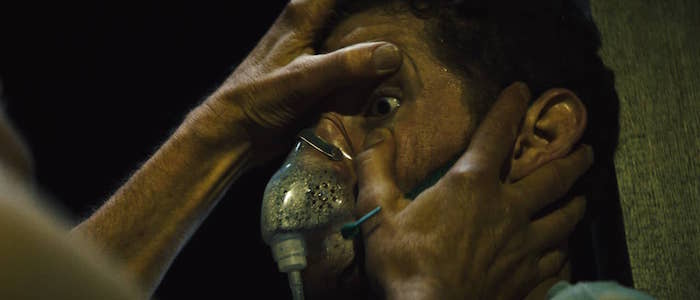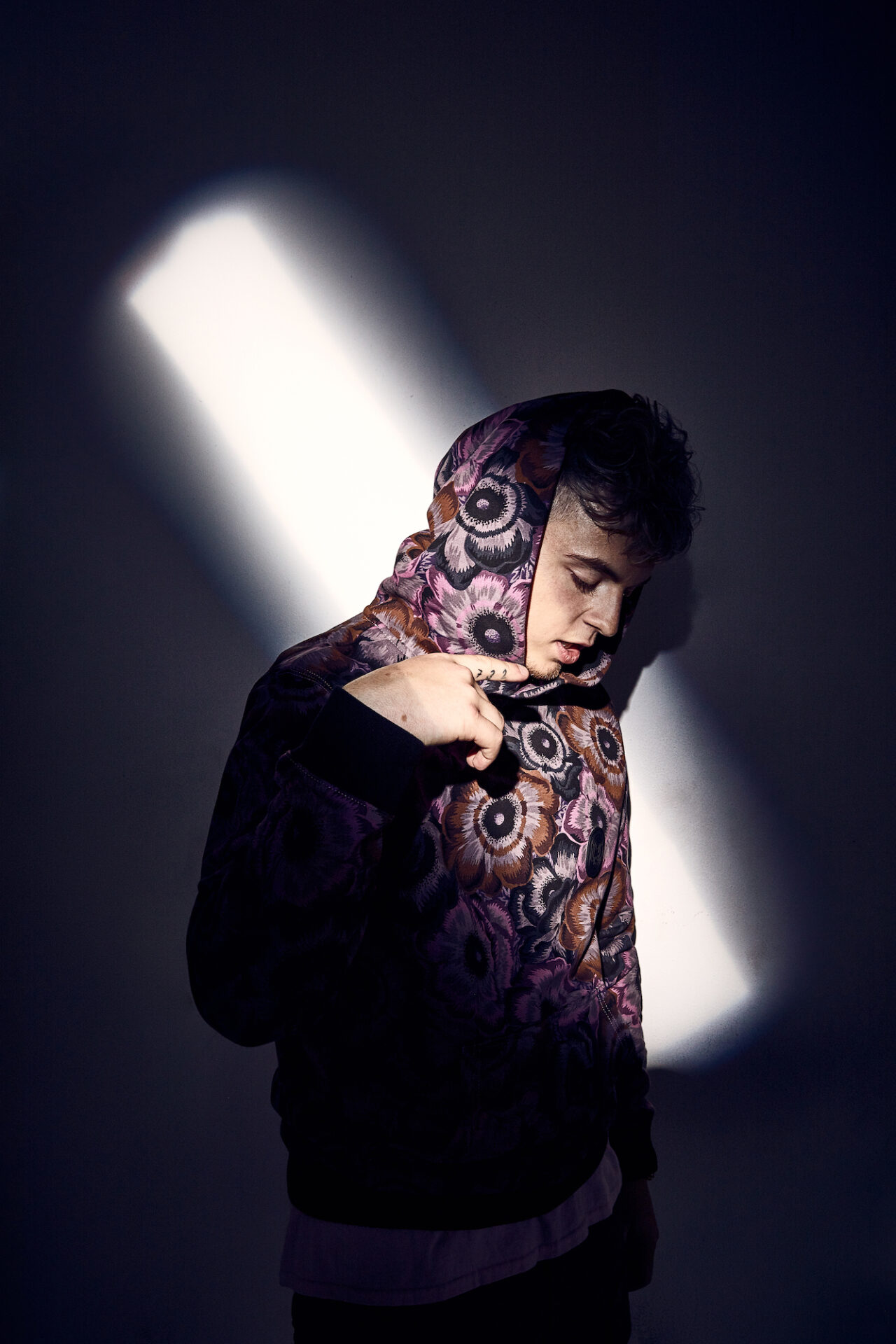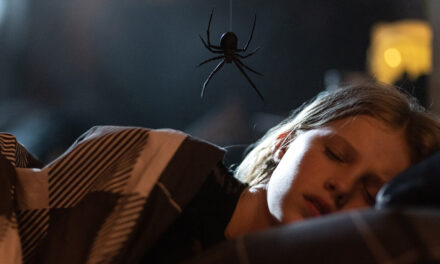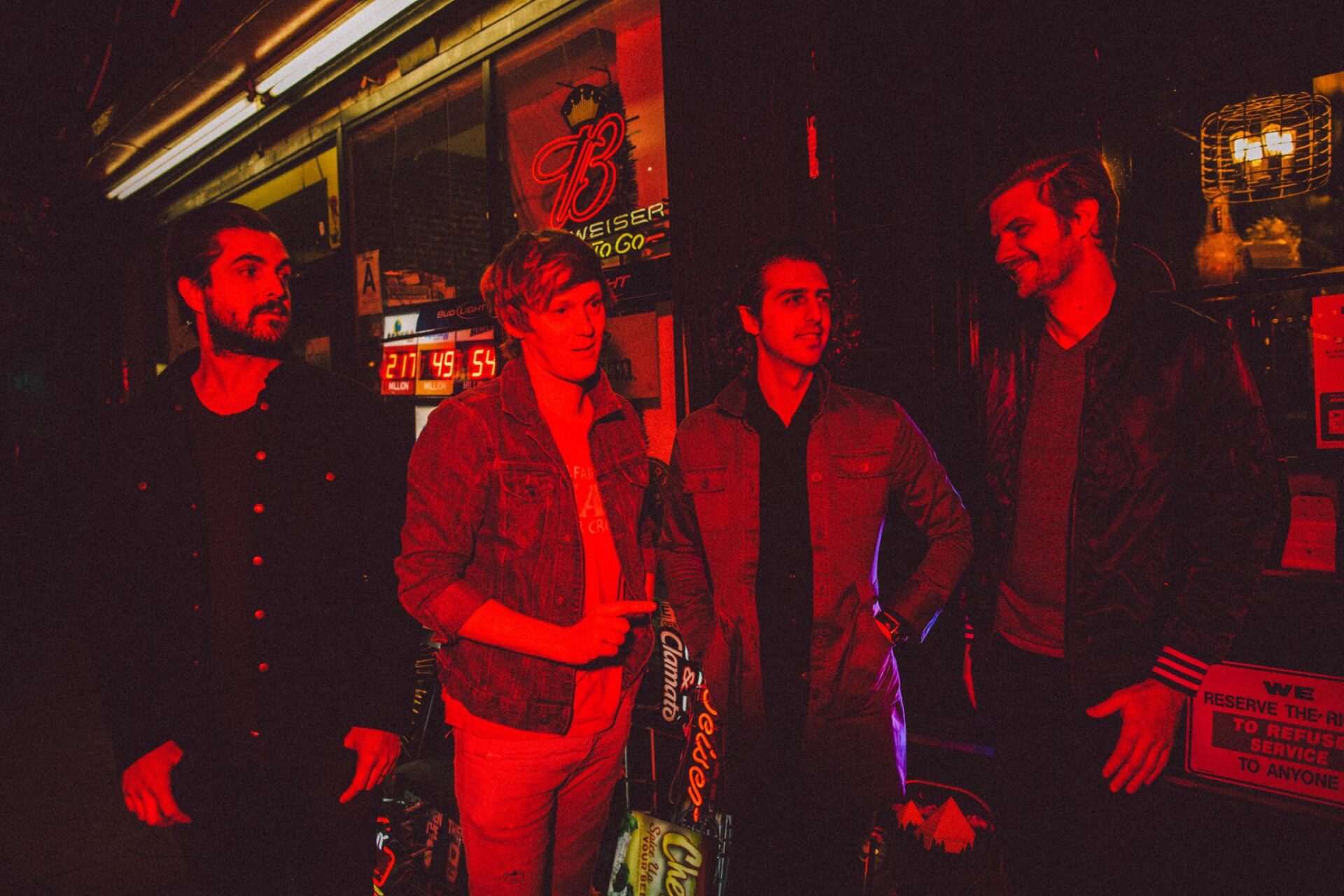Horror movies have had audiences scared of the unknown for ages. They have us thinking the worst in the endless terrain of the woods. Even checking our car’s maintenance twice before we go out on the road trip. You never want to take a chance of a deranged visitor having to pick you up to take you to safety. Still, nothing beats the lone house in the country. Who would be the type of person to live so far away from civilization and what macabre things could they be hiding?
With Honeydew, Sam (Sawyer Spielberg) and Riley (Malin Barr) are a couple that has a bit of a disconnect. Sam, an actor, and Riley, a Ph.D. student, decide to go on a camping trip together. Randomly picking a spot in the woods to stay the night would be the beginning of their wrong choices. Battery failure would have them seeking help in the house of an elderly woman named Karen (Barbara Kingsley) who has a love for cooking meat. First-time director Devereux Milburn elects to unwind the horrific mystery, one cooked steak slice after another. What lies behind the creaky floorboards and architecture of old rooms and furniture is a sinister secret that both characters will never forget.
We spoke to Milburn about the symbolism of food, what his influences were, and how he elected to use things such as sound design and shot selection to make his rural nightmare come to life.
I was thinking about Sam and Riley as characters. From the beginning, it’s shown that their relationship isn’t in the best shape. Riley is a Ph.D. student. Sam is an aspiring actor. There’s this thing where he practices his lines out loud, which could get grading. That divide between them grows as time goes on. Acclimating at the end of the film, which also includes the stylistic choice of the split-screen.
Devereux: Yeah, for sure. In post-production, it was. Initially, the split screens I hadn’t planned on. It came sort of organically after I put an assembly together, and it made sense to sort of separate them. Even when they’re in the same general area. It’s two people who get very different pleasures out of the world and are looking for very different things within it. That doesn’t mean that there aren’t a lot of commonalities between them. I obviously chose to focus less on their compatibility.
Sam finds a lot of pleasure in what he eats. Riley has more than a base knowledge of what’s healthy and what’s not. She’s focused on the sustenance that provides longer life, as opposed to keeping you unhealthy and inactive. Or a bubble of immediate gratification. Sam sees her criticism of how and what he eats is as nagging. In reality, it’s her effort to keep them safe and keep them alive. Once they get to the end, you see that she had the right idea. She was the one who was less enthusiastic about staying over at the house. Or eating the food to start. There’s some sort of hold that Karen has over him. It seems to be a function of her offering him whatever he wants to eat. It’s ultimately not to his benefit.
It’s funny that you mentioned that because there’s a particular way that Honeydew depicts food, Riley’s a vegan, and when they first when they sit at the dinner at Karen’s, she’s adamant that Sam can’t eat me. Once they settle in, Sam sneaks down and eats it, anyway. As they stay in the house more (particularly with the shower scene), Sam becomes more animalistic. He gives into something he was previously repressed from. It almost feels like Hansel and Gretel where the witch feeds the kids anything they want. Well, we all know how that turns out.
The Hansel and Gretel theme was introduced closer to the final draft. I didn’t initially have that in mind, and then I realized it became that. There were even some decisions I made where I discovered that it sort of had parallels there. Definitely, at least from a story perspective, there’s a hypnotic element as far as the food. In treating how the food looked, there was not a lot of care. Partly because of uncertain days, when we would shoot the scenes where Sam was eating at the dinner table. There were days when we had time to treat the food a bit more. Where we had time to make it glisten. There were other days when we just were so focused on getting the shot and the take. It was more incidental that the food appeared more decadent than it was. The time that we took the most care with it was actually later on in post-production.
Sam from the jump is just a pleasure-seeking missile. You mentioned the shower sequence. I remember someone wrote a review, saying, and I’m paraphrasing, “who does that in such a creepy house? And in such a creepy sort of atmosphere? “Sam does because he’s sort of living in a world that’s gradually being sucked dry of immediate gratification. He’s been used to having a hand and which Riley is sort of siphoning away for good reason. At that moment, it’s the one thing that he has that can serve as a substitute. Then obviously, eventually, he goes upstairs and really goes to town. In certain schemes, there was some caretaking to emphasize the hold red meat can have on someone who just loves it. Especially when it was in the pan.
With the trio of Karen, Eulis, and Gunni, there are some parallels between Leatherface and his family in The Texas Chainsaw Massacre series. Or even movies like The Hills Have Eyes. Eulis is the hand, but Honeydew reveals that Karen is the monster. She seems like she’s just this diminutive old lady that has an affinity for cooking, but Karen is the one orchestrating all the horror.
Yeah, for sure. Karen doesn’t really pretend to be comforting right off the bat. Whereas, there is some element of that with certain characters in TCM. Moments where you can be fooled into thinking you’re being saved. Karen fills that role at the start, and then gradually it becomes very obvious that she’s the greater evil. With the Leatherface thing, it’s funny because I didn’t notice any parallels until I was editing the film. I initially wrote Gunni as an old man. We’re supposed to think that he was the brother of Karen. Then, I realized I wanted someone younger and closer to Sam’s age. Someone who is larger and personifies the epitome of someone Sam could become. Essentially, he does by the end of the film.
Speaking to the ridiculousness of the seizures, there’s a bit more of a foundation and an established genesis about why he’s having them. Also, something about why people are acting the way they are. Whereas in Texas Chainsaw, it’s a bit vaguer. Or sort of based around general psychosis and insanity. The outcomes are very much the same. The dinner scene, again, was not deliberate at the start. Then I sort of realized as I was reading it, “oh, there are a lot of similarities.” A lot of obvious weirdness coupled with an obvious creep factor at play that they’re just doing their best to ignore. The difference is Sam and Riley are not being held captive yet. They sort of still have the free will to leave.
Sound design plays a big part in Honeydew paired with John Mehrmann’s score. They both give small breadcrumbs into more of the psychological aspect of these characters. Every little jump of an instrument or just the sound of the woods serves to heighten tension. It’s almost as effective as a jump scare. How did you manage for everything to come together like that?
I think the first moment that I realized how big sound design would be a factor is when we visited the location at nighttime. I heard the crickets, cicadas, and the sonic force of the landscape. When we were deciding the location, we wanted to use; we found this great house. There was just so much to pull live audio from and to inspire a score like John’s. It really just came to life. Raphaël Ajuelos, the sound designer tag-teamed the soundscape with John. I would apply elements of what we already heard from John’s score, or samples that John had put had sort of pulled out to some of Raphaël’s sound design. Then Rafael would build on that. He’d go have a bunch of people take Foley. From there, he created sound effects that, in some ways, mirrored or expanded on elements of the score. With the score itself, John was on set for a day or two. He gathered a bunch of ideas.
Then, I had a bunch of ideas that threw in a bunch of references. The first was Jack Nitzsche’s One Flew Over The Cuckoo’s Nest score, which I think employs a bandsaw. I always loved the airiness and wobbliness of that sound. I sort of combined that with some albums I’m listening to. From the Desperadoes Steel Orchestra, where they were doing covers of a bunch of Bach organ cubes It reminded me of horror films from the 50s and 60s. At the front of the film, there was a bit more of a melody. Then you know, I sent John scenes from Punch Drunk Love and that Jon Brion score. Also, the Under The Skin score, which are the Mica Levi compositions. There is a lot of percussion that comes out and interacts with the actual sound design.
John knows how to play every instrument. He knows how to make instruments out of nothing and how to create sounds with his body. Things that you just wouldn’t think you could make music from. I think he’s a real genius with composing and performing.
You and cinematographer Dan Kennedy worked to define a unique visual look to Honeydew. Especially in terms of distance and the angles we see the characters in. Did you initially storyboard or have an overall idea of how you wanted the film to look and feel?
Yeah, definitely. Dan and I spent a lot of time short-listing and breaking down shot designs. One film we watched was Rosemary’s Baby. That was a big one that I returned to that for just about everything. From the writing to the directions, but especially the cinematography. There aren’t a lot of cuts in most of the scenes in Rosemary’s Baby. Especially in the first half of the film. A lot of the film is shot wide, and I really liked that idea. The Thing was definitely an influence in terms of being an unknown, dark landscape surrounded by dark and mystery.
We capitalized on that, especially for the exteriors. The Devils and The Stalker were films I watched a lot. But yeah, I really wanted we wanted to have a vintage look. That went into Dan’s selecting the lenses and choosing the angles to shoot. We wanted to have something that was inherently horror, but not over the top. Simply because the film itself is a slow burn in many ways. We didn’t want to promise anything right off the bat that we would not deliver until the end. As we got closer to the end and closer to everyone, we used more long lenses A bit more handheld, especially once things get a little even crazier. All of those things factored into the look.
Honeydew makes its VOD and Digital HD release on April 13, 2021.













